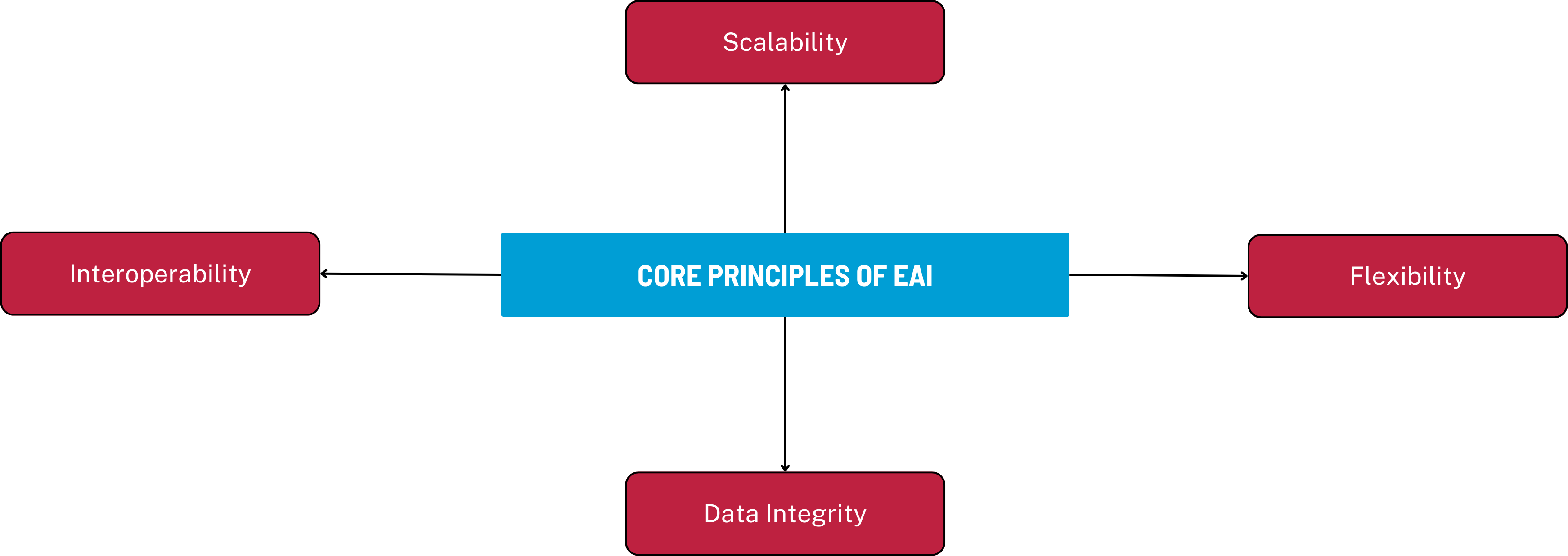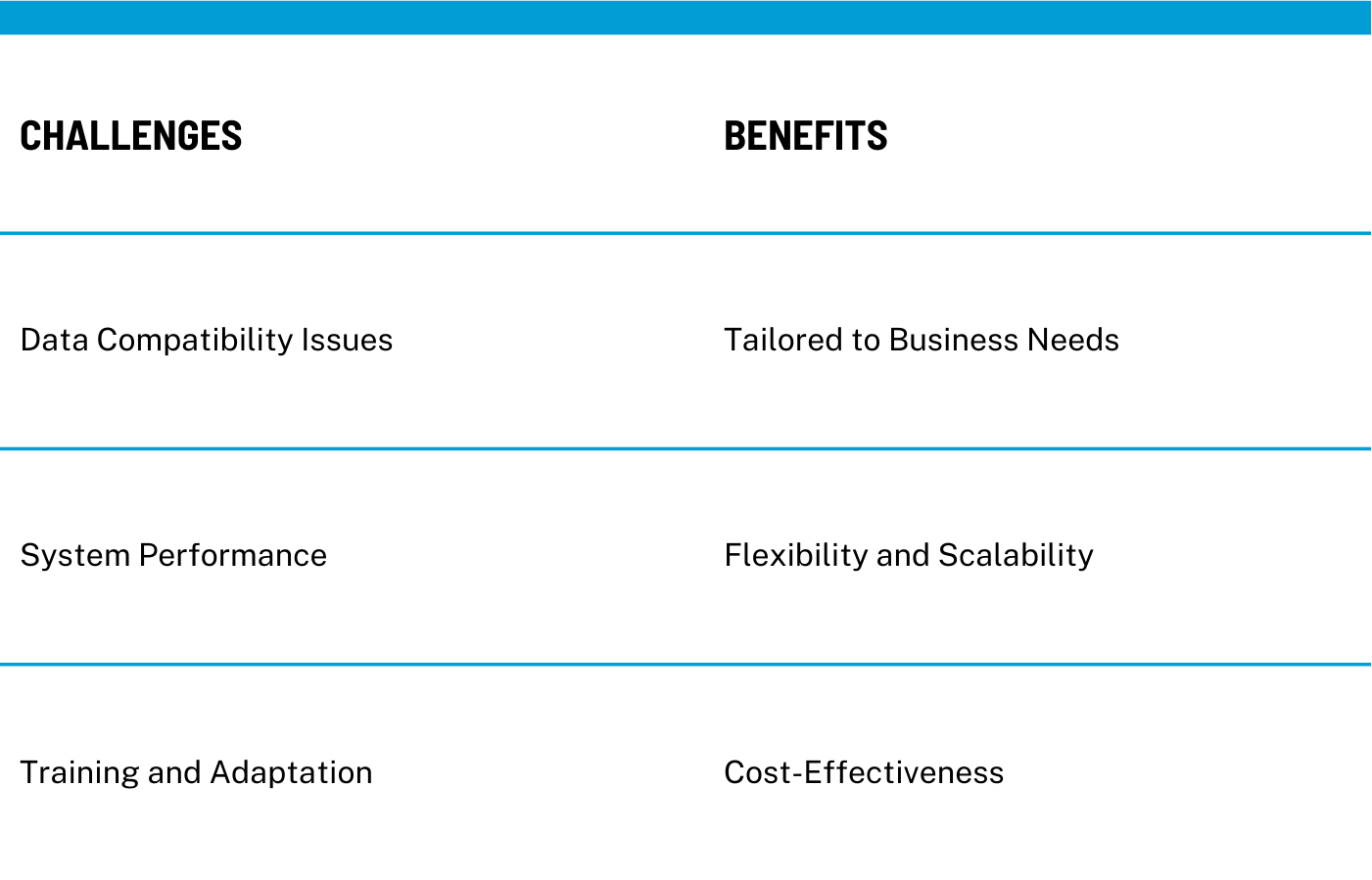In the era of digital transformation, Enterprise Application Integration (EAI) has emerged as a pivotal strategy for businesses seeking to streamline operations and enhance efficiency. EAI involves the synchronization of disparate business processes and systems, ensuring seamless data flow and consistency across various internal corporate software applications. This integration is vital for maintaining operational coherence in today’s complex business environments.
The Imperative of EAI for Modern Businesses
Modern enterprise technology landscapes are often a complex tapestry of isolated applications, each meticulously designed to serve specific business functions. This array of standalone systems, while individually effective, can lead to a fragmented technological environment, requiring custom business software development services. Such fragmentation is characterized by:
- Inconsistent Data Management: Different applications may generate and store data in diverse formats, leading to discrepancies and data silos.
- Process Inefficiencies: When systems operate in isolation, process redundancies and inefficiencies become prevalent, impacting overall productivity.
- Limited Collaboration: The lack of interconnected systems hinders the seamless exchange of information, restricting collaborative efforts across departments.
Enterprise Application Integration (EAI) addresses these critical issues by providing a unified platform where disparate systems can interact and operate cohesively. EAI facilitates:
- Effective Communication and Collaboration: It bridges the gaps between different systems, allowing for uninterrupted data flow and shared processes.
- Streamlined Business Operations: EAI eliminates redundancies by integrating related functions, thus enhancing operational efficiency.
- Unified Data View: It consolidates data from various sources, offering a comprehensive and consistent view essential for informed decision-making.
The strategic alignment of business processes through EAI is especially crucial during phases of digital transformation. As businesses evolve, the integration of innovative technologies with existing legacy systems becomes imperative to maintain competitive edge and foster growth. This integration often involves:
- Incorporating New Digital Solutions: Seamlessly integrating cutting-edge digital tools with core business applications.
- Legacy Software Modernization: Updating or replacing older systems to work harmoniously with newer technologies, as seen in approaches like legacy software modernization.
By aligning diverse applications and systems, EAI not only enhances current operational efficiency but also lays a solid foundation for future technological advancements and business growth.

Core Principles of EAI
The efficacy of Enterprise Application Integration is grounded in several fundamental principles, each playing a crucial role in the seamless integration of disparate business systems. These principles include:
Interoperability: This is the cornerstone of EAI, enabling different applications and systems to communicate and exchange data effectively. It involves standardizing data formats and protocols to ensure that information can be shared accurately and promptly across various platforms.
Scalability: As businesses grow and evolve, their EAI solutions must be able to scale accordingly. Scalability ensures that the integration framework can handle increasing volumes of data and transactions without compromising performance.
Flexibility: The dynamic nature of business processes requires EAI solutions to be flexible, adapting to changing business needs, technological advancements, and evolving market trends.
Maintaining Data Integrity: Ensuring that data remains consistent and accurate across all integrated systems is crucial for reliable decision-making and operational effectiveness.
EAI strategies range from simple point-to-point integrations, where two applications are directly connected, to more complex models involving middleware. Middleware-based approaches provide a central platform that facilitates communication between multiple applications, reducing dependencies and streamlining data flow.
Implementing EAI effectively demands a deep understanding of a business’s unique requirements. This understanding is crucial in tailoring EAI strategies to align with specific operational needs, as seen in customized approaches like software development from scratch, where solutions are uniquely crafted to address individual business challenges.
EAI Implementation Strategies
Selecting the appropriate EAI strategy is a critical decision that significantly influences the integration’s success. This selection process involves:
- Assessing Business Requirements: Understanding the specific needs of the business, including data sharing frequency, types of systems to be integrated, and the desired level of automation.
- Evaluating Existing Infrastructure: Analyzing the current technological landscape of the organization to determine the most compatible integration approach.
- Choosing the Integration Model: Depending on the assessment, the integration model could range from direct application-to-application connections to more comprehensive solutions involving an integration platform.
The goal is to establish an integration framework that meets the business’s real-time data sharing, process automation, and unified communication needs. Each strategy offers different benefits, and the choice often hinges on factors like the complexity of the business environment, budget constraints, and long-term scalability.

Integration Challenges and Advantages of Custom EAI Services
Implementing EAI solutions is not without its challenges, but the advantages of custom EAI services often outweigh these hurdles. Key challenges include:
- Data Compatibility Issues: Ensuring different systems can effectively communicate requires addressing data format and structure differences.
- Maintaining System Performance: It’s vital to keep systems operational and efficient during the integration process.
- Training and Adaptation: Equipping staff with the necessary skills to manage and utilize the integrated systems effectively.
Overcoming these challenges involves a strategic approach, emphasizing seamless integration with minimal disruption. Collaboration with in-house teams is crucial for effective management of newly integrated systems. This cooperative strategy extends to integrating new solutions with existing enterprise applications, ensuring a smooth transition.
Custom EAI services offer significant benefits over generic solutions:
- Tailored to Business Needs: They are designed to meet the specific requirements of a business, ensuring a better fit and more effective integration.
- Flexibility and Scalability: Custom solutions can adapt to the evolving needs of a business, providing long-term utility and adaptability.
- Cost-Effectiveness: While the initial investment may be higher, custom EAI solutions often lead to greater savings in the long run due to reduced need for modifications and maintenance.
The Evolving Landscape and Future Directions of EAI
The landscape of EAI is in constant evolution, shaped by technological advancements and shifting business demands. Current trends influencing EAI include:
- AI and Machine Learning Integration: These technologies enhance the analytical capabilities of EAI solutions, enabling more intelligent and efficient data processing.
- Cloud-Based Solutions: The shift towards cloud-based EAI offers enhanced flexibility, scalability, and reduced infrastructure costs.
EAI also varies significantly across different business sectors, tailored to address specific industry challenges. For instance, in the retail sector, EAI integrates e-commerce platforms with inventory management systems, while in healthcare, it is crucial for unifying patient records with billing systems.
Looking to the future, EAI is set to become even more integral to business operations. The increasing reliance on data and the need for agile, responsive business processes will drive further advancements in EAI. We can expect to see more sophisticated integration techniques, incorporating cutting-edge technologies, and methodologies. This ongoing evolution will propel businesses toward greater operational efficiency, agility, and a stronger competitive position.
The Takeaway
Enterprise Application Integration (EAI) stands at the forefront of digital transformation, offering a pathway for businesses to achieve seamless interconnectivity and operational excellence. As we’ve explored, the implementation of EAI comes with its unique set of challenges, but the advantages it offers in terms of tailored solutions, scalability, and long-term cost-effectiveness are unparalleled.
The evolving landscape of EAI, marked by advancements in AI, machine learning, and cloud-based solutions, points towards an even more integrated and efficient future for business operations across various sectors. By embracing these changes and continuously adapting to new technologies, businesses can ensure they remain agile, efficient, and competitive in a rapidly changing digital environment.
As you consider the integration journey for your business, remember that the right EAI strategy can transform your operations and position you for future success. For more insights or to discuss how our EAI solutions can benefit your business, please contact us. Our team is ready to help you navigate the complexities of EAI and unlock the full potential of your enterprise systems.